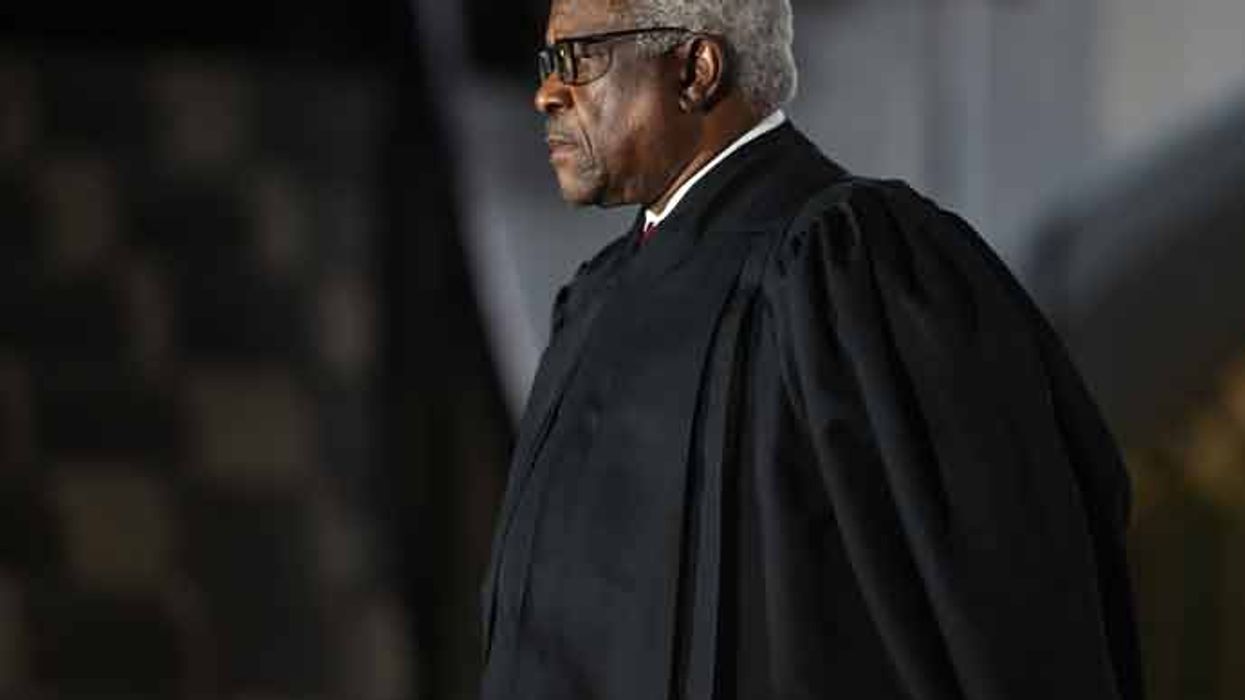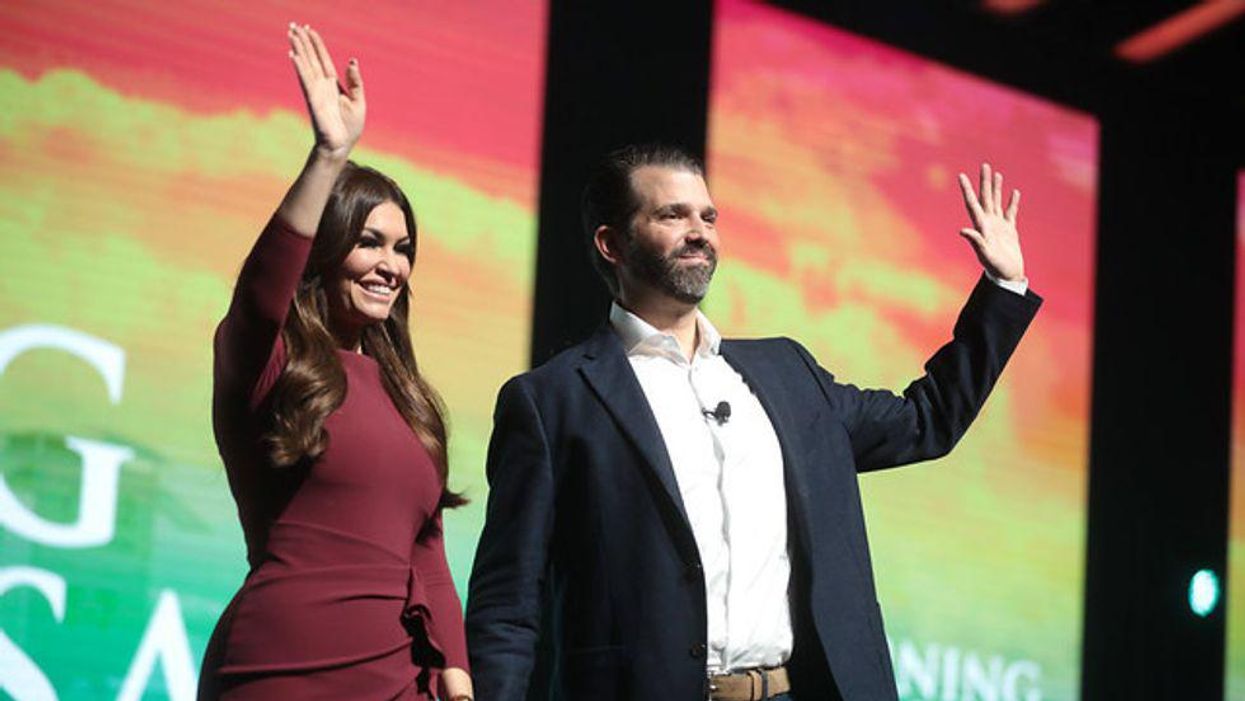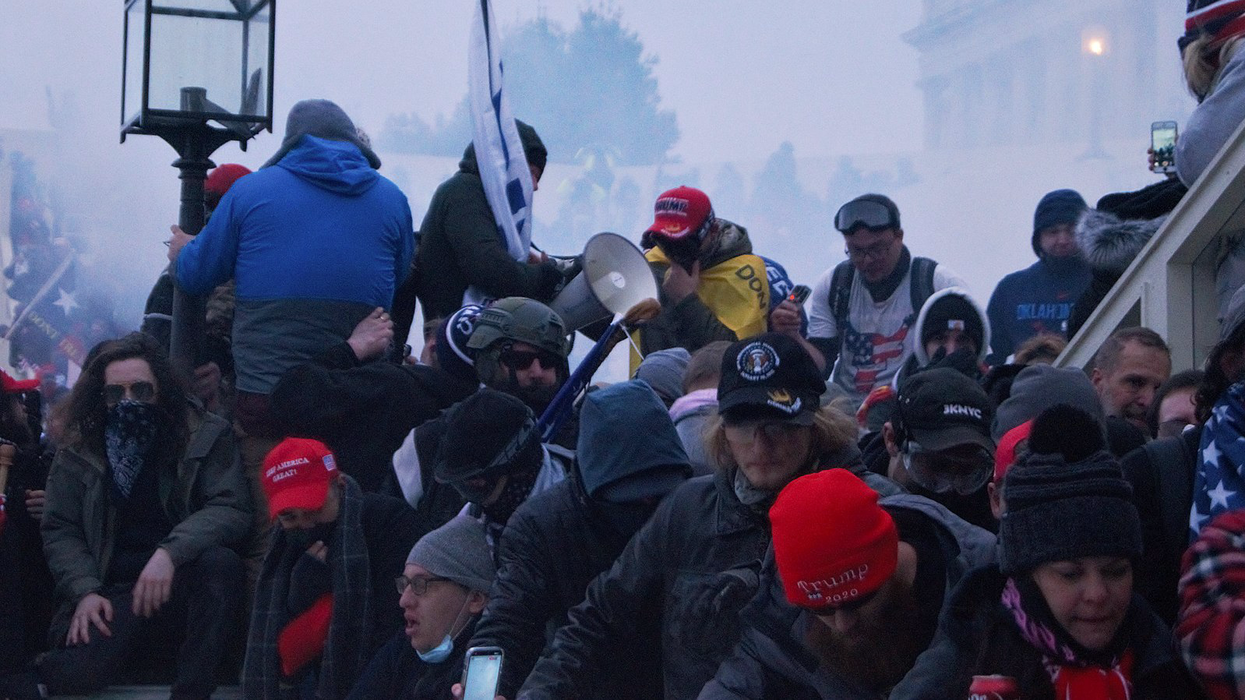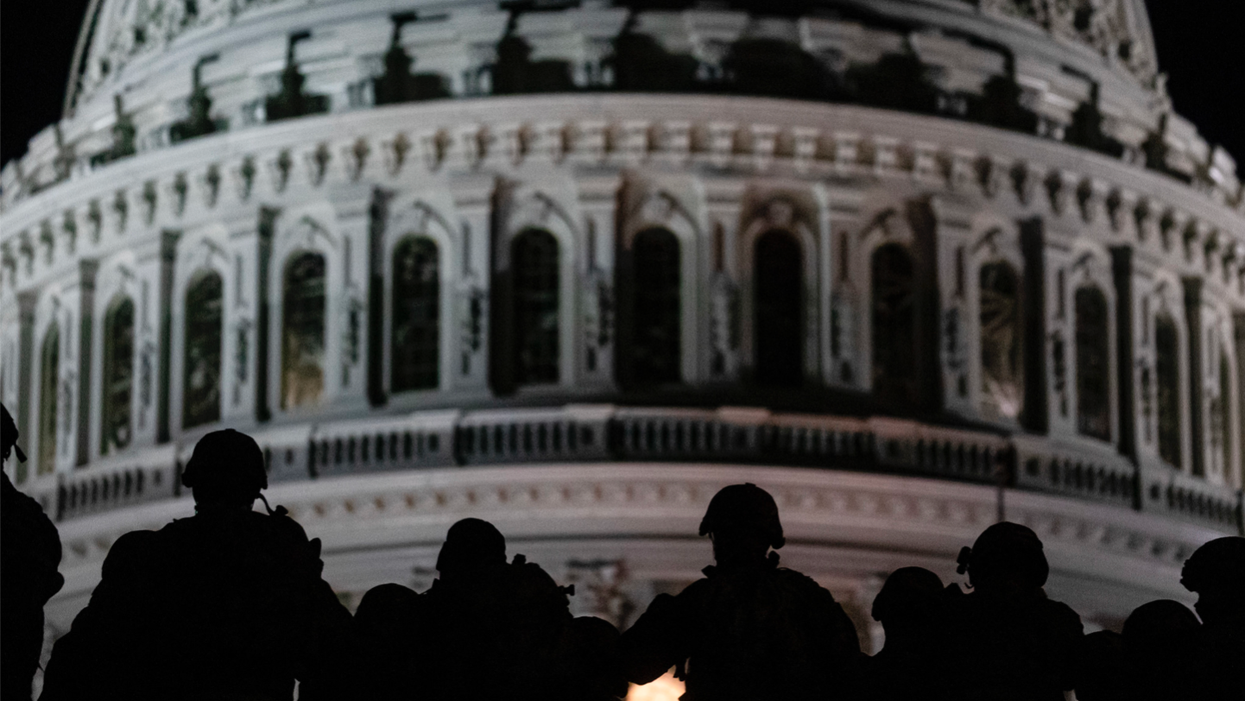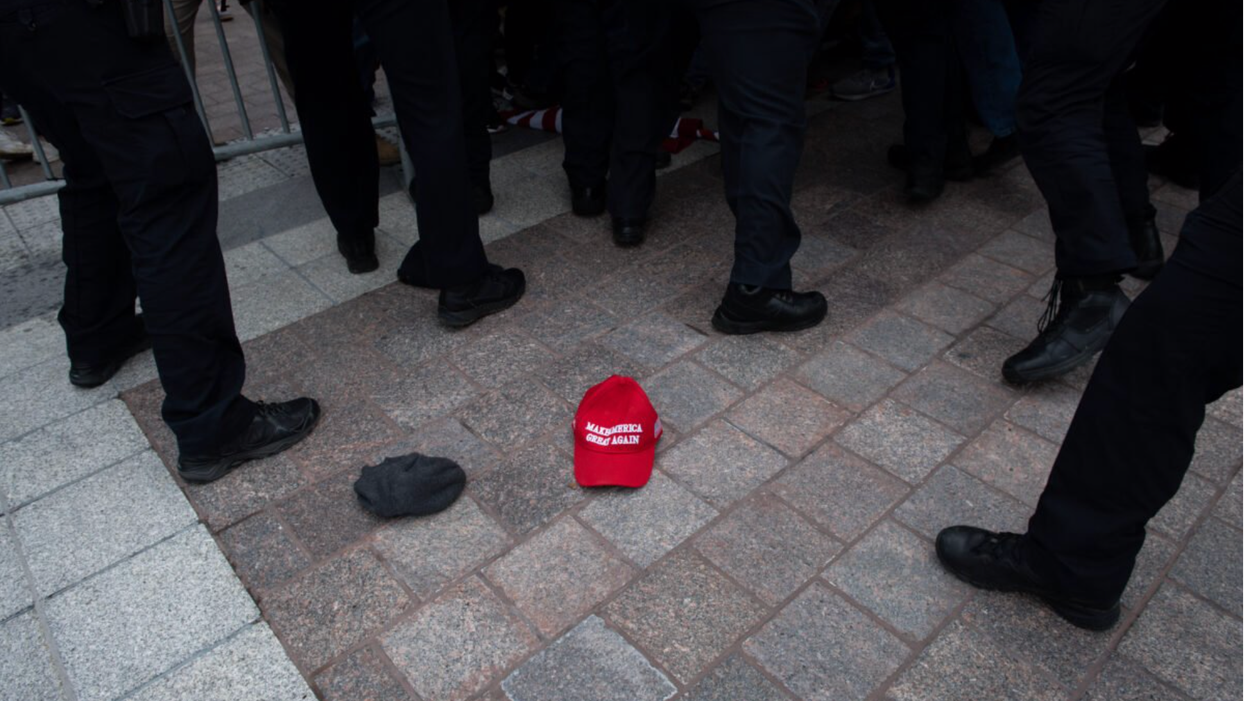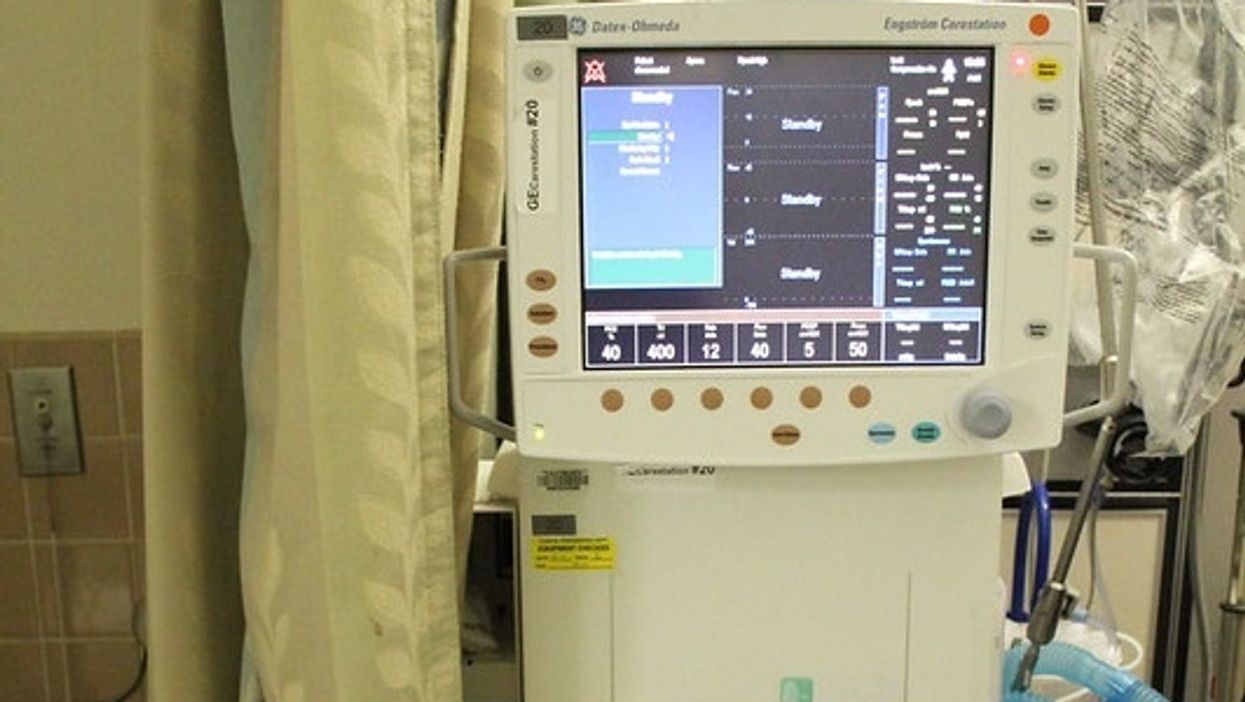The riot squad defending the embattled entrance to the west side of the U.S. Capitol was surrounded by violence. Rioters had clambered up the scaffolding by the stage erected for the inauguration of President Joseph Biden. They hurled everything they could get their hands on at the cops beneath: rebar, plywood, power tools, even cans of food they had frozen for extra damage.
In front of the cops, a mob was mounting a frontal assault. Its members hit officers with fists and baseball bats. They grabbed at weapons slung from the officers' waists. They unleashed a barrage of M-80 firecrackers. Soaked in never-ending streams of bright orange bear spray, the officers choked on plumes of acrid smoke that singed their nostrils and obscured their vision.
One officer in the middle of the scrum, a combat veteran, thought the rioters were so vicious, so relentless, that they seemed fueled by methamphetamine. To his left, he watched a chunk of steel strike a fellow officer above the eye, setting off a geyser of blood. A pepper ball tore through the air over his shoulder and exploded against the jaw of a man in front of him. The round, filled with chemical irritant, ripped the rioter's face open. His teeth were now visible through a hole in his cheek. Blood poured out, puddling on the pavement surrounding the building. But the man kept coming.
The combat veteran was hit with bear spray eight times. His experience overseas "was nothing like this," he said. “Nothing at all."
Over the last several weeks, ProPublica has interviewed 19 current and former U.S. Capitol Police officers about the assault on the Capitol. Following on the dramatic video of officers defending the building that House lawmakers showed during the first day of the impeachment trial of former President Donald Trump, the interviews provide the most detailed account to date of a most extraordinary battle.
The enemies on January 6 were Americans: thousands of people from across the country who had descended on the Capitol, intent on stopping Congress from certifying an election they believed was stolen from Trump. They had been urged to attend by Trump himself, with extremist right-wing and militia leaders calling for violence.
Many of the officers were speaking to reporters for the first time about the day's events, almost all anonymously for fear of retribution. That they spoke at all is an indication of the depth of their frustration over the botched response. ProPublica also obtained confidential intelligence bulletins and previously unreported planning documents.
Combined, the information makes clear how failures of leadership, communication and tactics put the lives of hundreds of officers at risk and allowed rioters to come dangerously close to realizing their threats against members of Congress.
In response to questions for this story, the Capitol Police sent a one-sentence email: “There is a multi-jurisdictional investigation underway and in order to protect that process, we are unfortunately unable to provide any comment at this time."
The interviews also revealed officers' concerns about disparities in the way the force prepared for Black Lives Matter demonstrations versus the pro-Trump protests on January 6. Officers said the Capitol Police force usually plans intensively for protests, even if they are deemed unlikely to grow violent. Officers said they spent weeks working 12- or 16-hour days, poised to fight off a riot, after George Floyd was killed by Minneapolis police — even though intelligence suggested there was not much danger from protesters.
“We had intel that nothing was going to happen — literally nothing," said one former official with direct knowledge of planning for the Black Lives Matter demonstrations. “The response was, 'We don't trust the intel.'"
By contrast, for much of the force, January 6 began like any other day.
“We normally have pretty good information regarding where these people are and how far they are from the Capitol," said Keith McFaden, a former Capitol Police officer and union leader who retired from the force following the riot. “We heard nothing that day."
For the members of the riot squad who formed the first line of defense on the Capitol's lower west terrace on January 6, the lack of information could not have come with higher stakes.
Thrust into the most intense battle of the insurrection, the roughly two dozen officers bought lawmakers crucial time to scramble for safety. For about 100 heart-pounding minutes, they slipped and skidded across a stone surface slick with blood and bear spray, attempting to hold their ground against a rampaging mass of thousands.
To many of them, it felt like no one was in charge of the Capitol's defense. All they could hear on the police radio were desperate cries for help.
At one point, the combat veteran was forced to stumble back from the line, his face so covered in bear spray he could barely see or breathe.
When he came to, a surge spilled over to his south. The crowd pushed over several bike racks. He realized the unfathomable had happened. His squad had lost the line; the mob could now enter the Capitol. There was no choice but to fall back. The officers stumbled over blood and debris until they were pressed against a limestone wall at the rear of the terrace. The mob had them cornered.
The officers, drained from their standoff, found a narrow staircase leading to an entrance of the building. But it could fit only one officer at a time. So they took turns climbing it as the crowd closed in, screaming obscenities and threatening murder.
“You fucking faggots!" one shouted. “You're not even American!"
Waiting to climb the stairs, the combat veteran feared the worst. “This is where they'll find my body," he thought.
The Intelligence: “A Normal Fucking Day"
On the morning of January 4, members of a civil disturbance unit gathered in a briefing room. A small group of officers were shown a document from Capitol intelligence officials that projected as many as 20,000 people arriving in Washington that week. The crowd would include members of several militia and right-wing extremist groups, including the Proud Boys, the Boogaloo Bois and the white supremacist Patriot Front. Some were expected to be armed, according to one officer who attended the briefing. The document anticipated that there could be violence.
The officers weren't allowed to physically share the document with anyone else, but they relayed its substance to the rest of their squad in a separate meeting. Together, the unit members discussed possible scenarios and pored over a map of the Capitol and its surroundings to identify vulnerable areas that could erupt in conflict.
The iconic west front of the Capitol emerged as an obvious target. Donald Trump was going to speak at the Ellipse across from the White House; from there, it's a direct walk past the Washington Monument and the reflecting pool outside the Capitol to the western facade of the building. The riot squad knew that if the crowd was going to violently confront police, that's where it would probably happen.
But the intelligence the unit relied on to make that judgment was not widely shared within the department. Several officers assigned to other commands told ProPublica they received no warning whatsoever going into January 6. “We went to work like it was a normal fucking day," one said.
“It was business as usual," said another, who has been on the force for more than 15 years. “The main thing we were told was to be on the lookout for counterdemonstrators."
The Capitol Police force is made up of four main divisions, each responsible for safeguarding its own section of the Capitol complex. But ProPublica learned that these divisions operate in silos, often out of sync with one another. On January 6, their failure to coordinate led to disastrous results. One group of officers was left stranded, separated from their riot gear, which sat unused on a parked bus near the Capitol while unprotected officers endured beatings with metal pipes and flagpoles.
The officers said that in the past, weekly Capitol Police intelligence briefings had kept the force well-informed about potential security threats from upcoming events. But those briefings stopped years ago.
Several weeks before January 6, many officers were ordered by their leadership to return their helmets because they were so old, the officers said. One officer told ProPublica he had received his helmet decades ago, and the padding was rotted out. Many said their helmets were never replaced. On the day of the riot, the department only had helmets available in medium size, one officer said. Many officers didn't have gas masks. Most hadn't received riot training in years.
“They've been asking about this for over 10 years — this kind of equipment, this kind of training," said one officer, who asked for anonymity out of concern for retribution. “We've always talked about the big one."
McFaden, the officer who retired last month after more than two decades as a Capitol Police officer, said that the communication failure going into Januay 6 was consistent with recent history.
As second-in-command at the Capitol Police union, McFaden said, he met with then-Chief Steven Sund and other leaders of the force every two weeks.
“We'd consistently ask them, for years, 'What are the contingency plans for upcoming events?'" McFaden told ProPublica. “We'd always get either a no response, or that things were in flux and it's a national security issue and we can't divulge that information at this time."
In the absence of communication from the upper ranks on how to prepare, officers turned to social media or to each other.
One officer said he first heard about the planned protest a week before, when a friend from another federal agency called him to say, as he recalled: “You all are gonna have your hands full next week. You got some mean boys coming up there." The officer was confused. “What do you mean?" he replied.
As the day drew nearer, the chatter became more tense. Twitter and Facebook were abuzz with hotel rooms filling up, and Trump supporters were pouring into Washington, announcing their plans to initiate a “civil war" or “revolution." On a well-trafficked pro-Trump forum, one of the most popular posts from January 5 said Congress “has a choice to make tomorrow": certify Trump's victory, or “get lynched by patriots."
Officers, particularly the younger ones, spent shifts glued to their phones, forwarding ominous posts to their sergeants.
Similar warnings reached the Capitol Police's intelligence division. ProPublica obtained a previously unreported 17-page Capitol Police operational plan that showed select officials were notified of “numerous social media posts" encouraging protesters to arrive armed.
The document, which is dated January 5, also states that white supremacists and the Proud Boys were expected to attend the rally, along with “other extremist groups," including antifa, the left-wing movement that has clashed with far-right groups and drawn the ire of some Republicans. The plan called for “counter-sniper teams" on the Capitol dome and officers monitoring for concealed weapons, but did not discuss a potential breach of the Capitol.
Other intelligence reports reviewed by ProPublica reveal inconsistencies — a sign of internal confusion about how best to respond.
ProPublica also obtained four daily reports from the department's intelligence division that were shared widely among commanders of the force, spanning the dates January 4 through January 7. The documents make no mention of expected extremist groups or the possibility that demonstrators would be armed. Instead, they note simply that “folks could organize a demonstration on USCP grounds."
The intelligence reports provide a kind of threat scale that gauges the likelihood of arrests. The January 6 rally was scored as “improbable," meaning it had a 20% to 45% chance of resulting in arrests. Two small anti-Trump counterdemonstrations organized by local left-wing and antifascist groups were assigned the same risk level.
Sund, who submitted his resignation as chief of the Capitol Police on January 7, later said he had tried to call in the National Guard two days before the riot. He said the sergeants-at-arms — the House and Senate officials responsible for security of lawmakers — denied his request. Both officials have since resigned. Reached by phone, former House sergeant-at-arms Paul Irving declined to comment. Former Senate sergeant-at-arms Michael Stenger did not immediately respond to a message left by phone.
In an emailed response to questions for this story, Sund said he and other departmental leaders were not responsible for assigning risk levels to upcoming events, and that he is “not sure of the process" the Capitol Police intelligence division uses to assess risk. He said intelligence was shared with division commanders to pass along to their troops, and that he emailed the assistant and deputy chiefs on January 5 to ensure officers knew what to expect the following day. Sund also said “the force did much more to prepare for the events of January 6 than we did to prepare for BLM demonstrations," including expanding the perimeter around the Capitol and coordinating support from Metropolitan police. He said any “breakdown in communication" on January 6 was “surely the result of the extraordinary events of that day."
He also defended his actions in an eight-page letter to congressional leaders dated February 1, saying, in essence, that he and his fellow leaders did the best they could with the information they had.
Sund said he ordered an “all hands on deck" response, meaning every available officer “would be working." He said he deployed about 250 specialized crowd control officers, “approximately four platoons" of which were outfitted in riot gear. He said that during the riot he urgently requested help from a variety of federal and local agencies. He added that the Capitol Police ordered more helmets and received about 100 of them on January 4. But he acknowledged that “a number of systems broke down."
“I also wish we had had better intelligence and warnings as to the possibility of this type of military style armed insurrection," Sund wrote, pointing out that there was a shared responsibility across a number of agencies. “The entire intelligence community seems to have missed this."
Run-Up to the Riot: “If Something Happens, Just Find Work"
At 7 a.m. on January 6, an officer on the department's midnight shift finished work and got into his car near the Capitol. Already, swarms of people were walking past, waving Trump flags. He sat in the driver's seat for a minute, watching. He called up an old colleague and marveled at the crowd.
The officer was surprised his superiors were letting him off duty. During the Black Lives Matter protests last summer, the night shift had often been held over to help. But he hadn't heard anything from his bosses, so he drove home to the Maryland suburbs and went to sleep. When he woke up, he saw on television what was happening and sped back, following an unmarked police car that had its lights flashing.
Meanwhile, officers belonging to the riot squad were making their way into the district to start their shifts. They could see throngs of people pouring out of Union Station, the railway hub within sight of the Capitol. They, too, were startled by the number of people on the streets that morning — it seemed that at every red light, a hundred demonstrators crossed in front of them. The officers hurried to prepare themselves for a long day.
At 10 a.m., as Trump supporters began to gather to listen to the president, the riot squad held roll call at a building a few blocks from the Capitol steps. There was little new to share from the intelligence division. Instead, the riot squad's sergeants played clips found on social media: videos of protesters meeting in cities across the country, getting ready to drive to D.C. They told officers to make sure they had filters in their gas masks and snacks in their pockets.
With no real direction from their superiors, the sergeants tried to get their troops mentally prepared.
“You guys all drove in, you guys saw the same thing we did," one of the sergeants told the officers, according to members of the team. “If something happens," another instructed, “just find work."
The unit put on their riot gear: helmets and body armor. Shields were placed in strategic areas around the Capitol complex, though some officers later said they could not get to them. One sergeant gave officers a final warning. “If this goes good, then we'll laugh about it," he told them. “But if it goes bad, it'll change your life and you'll never forget about it. They'll talk about this for years and years and years."
The riot squad members got on a bus to await their orders.
Sitting in his gear, one officer was struck by the age range of the people in attendance. “People had their little kids, 2-year-olds, babies in strollers," he recalled. An elderly woman with a walker inched toward the Capitol: “Every two steps, she has to stop and catch her breath."
After about an hour, the radio crackled: A possible bomb had been found outside the Republican National Committee headquarters, southeast of the Capitol complex. Capitol Police officers raced to the scene.
On the bus, the information did not set off panic. Suspicious packages are discovered all the time on the Hill; usually they are false alarms.
Then another, more urgent call went out. A 10-33, code for an officer in distress. An officer had been knocked backwards and hit her head on a flight of steps. The outer perimeter surrounding the west front of the Capitol had been breached.
Normally, the sergeants on the bus would wait for orders. But one snapped. “Fuck this, we're going," he said. The bus steered around the Capitol, barely squeezing between parked cars and protesters that had clogged a drive alongside the building.
Realizing they were effectively marooned, the sergeants ordered the riot squad off the bus. They began to walk across a wide lawn outside the Capitol.
As the officers drew closer, they realized that the lower section of the building's west terrace was guarded only by what is known as a “soft squad," officers with little protective gear dressed in neon yellow outerwear and baseball caps. The rioters were attempting to pull away metal barricades known as “bike racks," and striking officers with their fists. With about 150 yards to go, the squad members broke into a dead sprint.
Once they reached the lower steps, the riot officers spread out behind the soft squad, tapping its members out, one by one. The riot squad came into formation in front of their less-protected colleagues: about two dozen officers attempting to hold 120 feet of open space, behind the line of barricades.
Looking out toward the Mall and the Washington Monument, the squad realized the grass had disappeared from view, blocked out by a crowd of thousands.
The Attack: “Pick a Side"
At about 1 p.m., Trump gave a rousing speech to protesters, suggesting they head to the Capitol to protest the election certification. “We're going to walk down" to the Capitol, where they must “fight," he said.
“We're going to the Capitol," he told the increasingly agitated crowd of protesters. “We're going to try and give [Republicans] the kind of pride and boldness that they need to take back our country."
Vice President Mike Pence had just arrived in the House Chamber. The lawmakers awaiting him still hadn't realized just how dire the situation was becoming.
To Sund, it was already clear that “the situation was deteriorating rapidly," he wrote in his letter. He requested support from a number of agencies, including the Secret Service, and asked the sergeants-at-arms to authorize the National Guard and declare a state of emergency. According to the letter, Sund recalled that Irving, the House sergeant-at-arms, said he “needed to run it up the chain of command."
Outside on the lower west terrace, the rioters had begun launching their offensive. At first, they pushed officers from across the bike racks, almost testing to see what they could get away with. Soon it became a fistfight. In what felt like minutes, it turned into an all-out brawl involving scores of armed rioters.
To the police on the line, it seemed like every time they shoved one protester back, three more surged ahead to take their place.
“Some of them, as they are holding a thin blue line flag, looked you dead in the eye and said, 'Pick a side,'" one officer told ProPublica.
One officer hit a demonstrator and watched a pistol pop out of the rioter's waistband. The officer picked the weapon up off the ground and, with no time or backup to initiate an arrest, put it in his pocket and continued fighting.
Plumes of tear gas billowed behind the police line. Officers were startled by the sight of department commanders joining their desperate troops to defend the Capitol.
Inspector Thomas Loyd, the man in charge of the department's Capitol Division, threw off his hat and raised his fists. Deputy Chief Eric Waldow waded into the crowd. With the build of a linebacker, he cut a menacing figure, throwing punches as the bear spray stained his white uniform orange.
The two are now revered by the department's rank and file, who complain that other leaders were missing in action. Waldow and Loyd referred ProPublica to the Capitol Police public information office, which declined to comment.
The only other high-ranking official who officers said they heard on the radio that day was Yogananda Pittman, the department's assistant chief for protective and intelligence operations. Multiple officers told ProPublica that Pittman addressed the troops only once on the radio, when she ordered that the Capitol be locked down. Loyd, the union said in a public statement in January, had already given the same order about an hour before.
Elsewhere, another riot squad was in even worse shape. These officers had been dispatched to help quell a group of protesters gathered near a monument west of the Capitol. But they had been instructed by their superior officers to leave their gear on a bus. Now they were separated from the bus, defenseless.
“They were holding back some protesters, with just bike racks," said McFaden. “Well, those bike racks actually were used as weapons against the officers. Who had the bright idea of sending a hard squad with no gear? ... The coordination was just not there."
McFaden said that one member of that squad was hit in the head by a bike rack and knocked unconscious.
As the battle raged, officers stationed away from the combat were still trying to figure out if they were authorized to respond. They heard calls on their radios for “all available units." But officers at fixed posts didn't know what that meant.
“How the fuck am I supposed to know if I'm available?" thought one officer, stationed at a perimeter post with no rioters in sight. The officer's supervisors didn't know either. The group decided to stay put: If they left, there was a chance their post could be overrun. They were stuck listening to their colleagues fight and cry for help over the radio.
McFaden was also stationed away from the rioters, tasked with guarding a parking garage on the Rayburn House Office Building's west side. From his post, he had a clear view of the battle on the west front, but he'd received orders to stay at the garage entrance. At 56 years old, he had worked for the Capitol Police House Division for more than 20 years. He was slated to retire in just a few weeks. Now he was watching, powerless, as flash-bang grenades went off in front of a building he was sworn to protect.
By this point, time had become a blur to the officers at the west front. But somewhere around 1:15 p.m., it felt for a moment like the cavalry arrived. Dozens of officers in black riot gear came over the wall on the south side of the terrace. Washington's Metropolitan Police Department, the only other members of law enforcement on the west front in riot gear that day, had arrived.
But the reinforcements could only slow the crowd. About an hour and a half after the Metropolitan police arrived, the rioters broke through the line. In the melee, a rioter was captured on video hurling a fire extinguisher at the Capitol police. It struck an officer in the head, giving him a concussion, according to his colleagues. That officer was one of at least two to be assaulted with such a device that day; another, Brian Sicknick, died from his injuries the following day.
The rioters pulled at least two of the Capitol Police officers in riot gear into the crowd, stealing their batons and pepper spray and setting off a kind of human tug of war, before other officers were eventually able to pull their colleagues out.
Soon, the police had their backs against a wall. They formed a semicircle, doing their best to defend themselves against jabs with flagpoles and shots from bear spray canisters and pepper spray guns.
The officers made their way toward the staircase leading up to the second floor of the west terrace. A line of officers pushed each other up the narrow steps. When they got to the terrace, they rushed through a door leading to the inside of the building. Metropolitan police formed a wall of riot shields behind them, sealing off the entrance.
The crowd never made it through the doors. Video footage shows a Metropolitan police officer trapped in the door, screaming in agony. As the police poured inside, some members of Congress were still on the House floor, yet to be evacuated.
At around this time, Sund was on a conference call with four different agencies and had just learned that he needed Pentagon approval to activate the National Guard. According to Sund's letter, Lt. Gen. Walter Piatt, the director of Army staff, remained skeptical. “I don't like the visual of the National Guard standing [in] a line with the Capitol in the background," Piatt said, suggesting that the guard relieve Capitol Police officers from their fixed posts instead. Piatt and the Department of Defense did not immediately respond to an emailed list of questions. (In a statement on January 11, Piatt denied making such a comment. He later acknowledged that he “may" have said it.)
Once inside, the riot squad searched desperately for water. The pepper spray and bear spray cocktail was overwhelming, seeping through the tiny breathing holes of their masks.
Officers spat out phlegm and vomited into trash cans. When they eventually found water, they rushed to wash the chemicals out of their eyes and put their helmets back on. They climbed up another flight of stairs to get to the Capitol crypt, the circular room directly beneath the rotunda.
As the officers ascended, they met more rioters, who were being pushed down the stairs by Metropolitan police. The Capitol police felt like they were swimming upstream through a mob, grabbing the protesters by their limbs and shoulders as they tried to reach the next level of the Capitol.
One officer said the crypt looked like something out of a Michael Bay movie, trash strewn everywhere, the air thick with smoke.
After the crypt was cleared, another officer made it to the Capitol rotunda. He said he still can't shake the scene: On the walls, a 19th-century frieze depicted the Battle of Lexington and the signing of the Declaration of Independence; on the ground, pepper balls whizzed into the crowd and the smell of chemicals wafted through the air.
McFaden, too, finally got a call to jump into the action, and was ordered to the rotunda. When he arrived beneath its domed ceiling, already breathless from the run over, he got hit in the face with bear spray.
“I felt like you could fry an egg on my forehead," he said.
The Aftermath: “I Don't Trust the People Above Me to Make Decisions to Bring Me Home Safe"
By about 4 p.m., other agencies had arrived in the rotunda: FBI SWAT teams, police officers from surrounding counties. Law enforcement moved in lines two or three deep, pushing the demonstrators out of the building's east doors.
With their guns drawn, officers teamed up and began searching the Capitol, clearing rooms one by one. Members of Congress were now huddled with their staff, cowering petrified behind furniture they had piled against their office doors.
The first 150 or so members of the National Guard finally arrived at 5:40 p.m.
“I still cannot fathom why in the midst of an armed insurrection, which was broadcast worldwide on television, it took the Department of Defense over three hours to approve an urgent request for National Guard support," Sund wrote in his letter. In response to questions for this story, the National Guard sent a timeline that confirmed their 5:40 p.m. arrival and referred ProPublica to a press release stating they worked with Capitol and Metropolitan police “to assist with an immediate response."
At around 8 p.m., Capitol Police declared the complex secure. It was pitch-black outside by the time the riot squad that fought on the west front reunited. There was little conversation. They sat exhausted on the steps by the Memorial Door, helmets at their feet, staring at each other in disbelief. Some hugged each other. Others cried.
One saw that he had missed 17 calls and nearly 100 text messages. High school friends he hadn't spoken to in years reached out on Instagram. In text after text, the same words: “I saw the news." “Call me when you get this." “I love you."
The messages made some of the news coverage that came later, in which police were accused of siding with the mob, easier to stomach. He knew nothing he had done that day could be construed as complicit with the rioters. It looked like at least some of his friends and relatives knew it too.
Several officers said they didn't get home until the early morning hours of the next day. One said when he got home he went straight to his washing machine to put his bear-spray-soaked uniform into a cold-water wash. Another said that he could not get rid of the smell or the itch of the chemicals for days.
For a week afterward, one officer said, he cried nightly. Three Capitol Police officers died in early January: Brian Sicknick, who was beaten over the head with a fire extinguisher; Howard Liebengood, who died by suicide following the riot; and Eric Marshall, who died of cancer four days before the riot. Almost 140 Capitol and Metropolitan police officers were injured, according to a union statement. One had two cracked ribs and two smashed spinal discs.
A week or so later, McFaden and union chair Gus Papathanasiou met with leadership for the first time since Sund's resignation on January 7. Acting Chief Pittman, Assistant Chief Chad Thomas and other senior officers were in attendance.
Loyd, the inspector who had thrown punches on the west front, was also there. McFaden had the sense that Loyd was only brought in to defuse tension with the union, which had more questions than leadership had answers.
Pittman acknowledged that the force was in a dark place and a culture change was sorely needed. But McFaden said the acting chief quickly became taciturn. When she was asked where she and her fellow chiefs were during the riot and why they weren't on the radio, she dodged the question.
Meetings with union leadership usually last at least an hour, but after 30 minutes, McFaden said, Pittman got up to leave for another engagement.
The union leaders were enraged. They turned to Thomas and asked why he wasn't on the radio that day.
“He said he was trying to do that for like 10 to 15 seconds, and he couldn't get on the radio," McFaden said. “This event lasted for hours. ... I mean, come on." Pittman and Thomas did not respond to calls for comment.
It was only through Pittman's testimony at a closed Congressional briefing on January 26 that most Capitol Police officers learned that the force did in fact have intelligence warnings of possible violence. She admitted that the department failed to adequately act on it.
The officers said they are still waiting for an apology. Many are looking for new jobs.
“Let's face it. Now the whole world knows where the vulnerabilities of the Capitol are," said one officer. “I don't trust the people above me to make decisions to bring me home safe."


